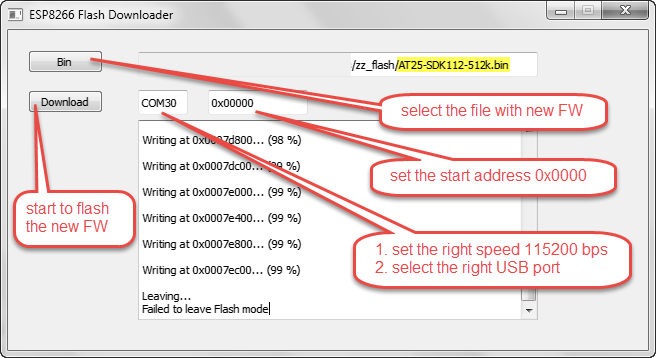-
• #27
I actually took Gordon's solution first because I didn't want to solder wires to the pins. And although it took some tweaking and slowing down comms to a strolling pace, it works. I now have AT25 on both "shimmed" ESP01's without having to desolder them. Which was the goal. But I am sure that your solution wouldn't have required the "tweaking".
-
• #28
@Ingmar_Guillaume OK, if the task is successfully fulfilled (new FW flashed) then the solution with USB is better... requires less sources.
BTW... There is no need to solder anything in my solution if you have pinned Pico... see the picture (Connection_flash.png).
For those who work under Windows I have following solution. The flasher and file with new FW are in the attachment. The procedure and short program for Pico are almost the same (only another flasher, see the picture Windows_flash.png) as in my contribution #6.var baud=115200; Serial1.setup(baud, { rx: B7, tx : B6 }); Serial2.setup(baud, { rx: A3, tx : A2 }); console.log("Start flash ->"); Serial1.on('data',function(d) {Serial2.write(d);}); Serial2.on('data',function(d) {Serial1.write(d);});
3 Attachments
-
• #29
@Ingmar_Guillaume ... the flasher is too big... I have to find another way how to send it... do you have any idea?
-
• #30
... everybody can download it here...
https://drive.google.com/file/d/0B-Emmah2G61sXzdUakp1aldIcmc/view?usp=sharing
 Ingmar_Guillaume
Ingmar_Guillaume profra
profra

 the1laz
the1laz
You are right in principle... but USB and USART2 are already used (USB->PC, USART2->ESP8266 on the shim). The task was (from my point of view) to flash new FW into ESP8266 "tightly soldered" on the shim. USART1 is free (or can be made free) for this "one-shot" task -> to flash new FW.... without any problems... which you describe in your solution to do the same through USB. It is not easy task because of USB OTG is packetizied communication. I guess the only reason for this solution is that not everybody has USB-UART available. Am I right?